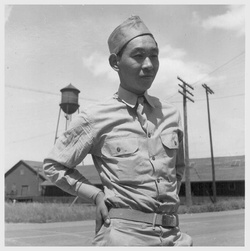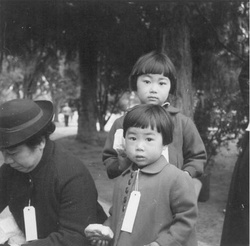Read Part 11 >>
“Everything Is Propaganda”
Lange’s outlook on life informed the pictures she took at Manzanar. Where Adams saw the rugged natural setting as spirit-lifting and awe-inspiring, Lange saw it as brutal and oppressive. Where Adams saw opportunity and triumph of spirit at Manzanar, Lange saw suffering and a gross breach of civil rights. Because most of her photos of the Japanese American evacuation and imprisonment were suppressed, and perhaps because American citizens were not ready for their message, it was not until the 1960s that many Americans were able to recognize Lange’s subject for what it was, as Susan Sontag described it: “a crime committed by the government against a large group of American citizens.”

Lange's caption describes how this Japanese-American soldier in Florin, CA, and nine other service men received furloughs so they could help their families prepare for evacuation. Lange notes, "He is the only American citizen in the family." (Source: War Relocation Authority Photographs of Japanese-American Evacuation and Resettlement Series 14)
Lange acknowledged that documentary photography as she practiced it conveyed a point of view and took sides. “Everything is propaganda for what you believe in, actually, isn’t it?...I don’t see how it could be otherwise. The harder and the more deeply you believe in anything, the more in a sense you’re a propagandist,” she said. In Impounded, Gordon describes Lange’s work as “saturated with conviction,” clearly shaped by her criticism of the WRA’s treatment of the Japanese.
Some critics, however, found Lange’s emphasis on the downtrodden aspect of her subjects’ lives to lack nuance. In their book accompanying the 1977 UCLA exhibit “Two Views of Manzanar,” Graham Howe, Patrick Nagatani and Scott Rankin pointed out that Lange’s reliance on her Farm Security Administration style at Manzanar meant that “the misery exponent was the only side of the relocated life that Lange revealed.” This left out, wrote Howe, the “resilience and determination of a people subjected initially to persecution and ultimately rising above that predicament.”

The Mochida children, of Hayward, CA, tagged like baggage, awaiting evacuation. One sibling holds a sandwich given to her by a local church group. Photograph by Dorothea Lange (Source: War Relocation Authority Photographs of Japanese-American Evacuation and Resettlement Series 14)
“Dorothea Lange couldn’t care less about print quality,” Patrick Nagatani elaborated in an interview. “She was always after the information, she was the true photojournalist.” Lange also sought the details that conveyed her beliefs. “Dorothea Lange had the exact image she wanted in her mind,” said Nagatani. “She probably had two pictures of the little kids [wearing I.D. tags], and in one of them, they’re smiling because, you know, it’s an adventure, and she said, ‘No way!’”
Ansel Adams’s work in Born Free and Equal was also a work of propaganda, but one that Lange could not condone. Lange and Adams were friends, collaborators on several Fortune stories, and to some extent, rivals. The relationship between Lange and Adams was not always a smooth one. At a 2010 reading of her biography of Lange, Dorothea Lange: A Life Beyond Limits, Gordon said of the two photographers’ friendship: “They fought a lot.” Lange once commented that Adams, most famous for his heroic landscapes of the Sierra Nevada and the West, “made rocks look like people.” Adams, in turn, sniped that documentary photographers “were social scientists with cameras.” Yet despite their open arguments, the two shared a deep and lasting friendship, Gordon said. Adams visited Lange when she was sick, wrote admiring and complimentary letters to her, and, during the 1930s, processed and proofed Lange’s film for her when she was on assignment for the FSA. In its volatile ups and downs, explained Gordon, their relationship was “almost familial.”
Their political disagreements were fundamental as well. Lange was a natural champion of the oppressed. Adams had a knack for befriending the rich and the powerful, and lived a life of what Lange considered unseemly luxury. His Manzanar photographs were his only professional foray into charged political or racial territory. Yet at the same time, Gordon wrote, “Adams deeply respected, championed and promoted her photography.” In 1954, when Lange was asked by U.S. Camera to name the 25 greatest photographs of all time, she included an Adams’s photograph of an Alaskan mountain scene.
Later in life, Lange was more critical of Adams’s political views. “He’s ignorant on these matters,” she said of her colleague. “He isn’t acutely aware of social change.” In a conversation with the UC Berkeley oral historian Suzanne Reiss, Lange acknowledged, however, that Born Free and Equal represented a leap for Adams, and “was far for him to go…He felt pretty proud of himself for being such a liberal in that book.” Hammond, though, cautions against citing oral history interviews without having listened to the tapes (quotes can get distorted, or tone misunderstood) and asserts that the antagonism between the two photographers has been overplayed by Lange scholars “to crank up a sense of antagonism between Lange and Adams.”
The Revolutionary Use Value of Photographs
Another difference between the two photographers’ treatment of Manzanar was that Lange made a special attempt to stress the accomplishments of the prisoners, including their higher education degrees and former professions. Although constant harassment by military personnel at Manzanar prevented her from writing as extensive captions as those she wrote for her relocation photographs, she still managed to slip in such telling details. In one July, 1942 Manzanar photo caption, she wrote, “Henry Ishizuka, graduate of UCLA, now superintendent of the camouflage project which at this date employed approximately 500 workers at the evacuee scale at this War Relocation Authority center. Former occupation: Supervisor, Douglas Aircraft Plant, Santa Monica, Calif.” (The “camouflage project” the caption refers to was a large-scale army undertaking in which “volunteers,” pressed into service by camp administrators, were made to weave huge hemp nets designed to cover tanks.)

Lange's portrait of Manzanar prisoner Henry Ishizuka, whose accomplishments she enumerates in her caption. (Souce: War Relocation Authority Photographs of Japanese-American Evacuation and Resettlement Series 8)
For another Manzanar photograph of orphans at Manzanar’s Children’s Village, Lange’s caption reads, “Mrs. Harry Matsumoto, a University of California graduate, and her husband are the superintendents of the Children’s Village where 65 evacuee orphans from three institutions are now housed.”
Captions she wrote for photos of the families she selected to follow through the process of exile and imprisonment were even more extensive. For her portraits of the Shibuya family of Mountain View, Calif., for example, she explained that the children had been born in America, with four having attended “leading California Universities, one a student at Stanford Medical School, one holding a degree in plant pathology from the University of California.” Their father had emigrated from Japan with $60 and a basket of clothes and had become a successful grower of chrysanthemums, “which he shipped to Eastern markets under his own name,” she added.

Portrait of the accomplished Shibuya family of Mountain View, CA, pre-evacuation. Photograph by Dorothea Lange (Source: War Relocation Authority Photographs of Japanese-American Evacuation and Resettlement Series 14)
Lange’s extensive interviewing, note-taking and caption writing perfectly achieved what German philosopher and critic Walter Benjamin prescribed to counter the inevitable beautifying, and morally suspect, effect of photography. “It has succeeded in turning abject poverty itself, by handling it in a modish, technically perfect way, into an object of enjoyment,” he wrote. But a descriptive caption accompanying a photograph, Benjamin asserted, could “rescue it from the ravages of Modishness and confer upon it a revolutionary use value.” Benjamin’s observations on photography were influenced by his Marxist views; his passionate wish to see art, photography and cinema used to empower the working class is in accord with Lange’s view of her own work as propaganda in support of oppressed Japanese Americans. She sought to confer on her work “a revolutionary use value.”
© 2011 Nancy Matsumoto





